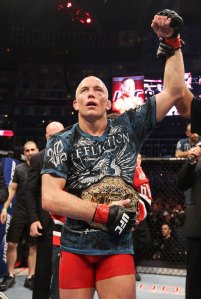 St-Pierre is the present; the evolution that brought us to this point, and someone fighters like McDonald, MacDonald and countless non-Donalds aspired to emulate in their training and development. At the same time as the welterweight champion represents where we are now, two other UFC title holders are showing that the next evolution of the sport could take multiple forms.
St-Pierre is the present; the evolution that brought us to this point, and someone fighters like McDonald, MacDonald and countless non-Donalds aspired to emulate in their training and development. At the same time as the welterweight champion represents where we are now, two other UFC title holders are showing that the next evolution of the sport could take multiple forms.
Light heavyweight champion Jon Jones embodies one of the next evolutions in the sport. A combination of focus and hard work, talent and athleticism, ingenuity and improvisation poured into a slender frame with a freakish wingspan, Jones appears unstoppable. While the history of the sport has proven no man is unbeatable, “Bones” looks as close as they come right about now.
Skilled across the board, what sets him apart as a symbol of the next evolution is the way it all comes together in the cage. Jones could just as easily land a powerful leg kick or textbook jab as no sooner than he execute a Scott Steiner-esque belly-to-back suplex on Stephan Bonnar. Who starts a championship fight they took on six weeks notice with a flying knee or does a reverse leapfrog over a turtled opponent to take their back?
Jones does, and that out-of-nowhere arsenal of weapons and the whats-he-going-to-do-next uncertainty his opponents must deal with are part of the reason he’s a symbol of one of the new evolutionary shifts in the sport. So as to not scare the rest of the light heavyweight world, I won’t mention that Jones would still probably be champion and difficult to defeat even if he just stuck to the fundamentals. He’s just got that much talent, and he works pretty damn hard too.
Dominick Cruz is also ushering in another evolution of the sport. Where Jones leaves opponents guessing what’s next, the UFC bantamweight champion has his challengers questioning where he’s going to attack from and if they will be able to hit him?
Though some deride his style as “point fighting” as if trying to inflict damage without accruing any is somehow a bad idea, Cruz sees it as a new and necessary evolution.
“This sport is evolving, and as it evolves, people are going to find ways to inflict more damage, to take less damage,” explained Cruz prior to his victory over Urijah Faber at UFC 132.
“This sport is going to [a state] where people are going to be so good at takedown defense that all these fights are going to be standing. If you go fight rounds on your feet, you’ve got to figure out a way to take less damage. If you don’t — with four-ounce gloves — you’re going to be put to sleep.”
With constant movement and attacks from all angles, Cruz keeps opponents off balance, unable to fully commit to coming forward because he’s never in the same place for very long. And he’s not just dancing out of danger either; Cruz is a voluminous striker, coming forward and connecting much more than the opposition.
Case and point: Cruz landed more strikes than Scott Jorgensen threw in their WEC 53 encounter. That’s not dancing or point fighting; it’s evolution.
The world’s best bantamweight sees a similar decrease in the effectiveness of jiu-jitsu as Herman.
“The wrestling is getting so good that a lot of the submission game is going to be — it’s not going to be completely shutout by any means — but it’s going to be minimized a lot. I think the takedown defense is just going to make a lot of these fights stand-up wars. Obviously, it depends on the styles of everybody, but I’m talking about the evolution of the sport, and that’s just what I’m seeing.”
Cruz’s essentially saying the same things as Herman; he just does a much better job of articulating it.
It’s not about the art being ineffective as a whole or jiu-jitsu players being unable to compete; it’s about athletes improving, learning, developing.
It’s about evolution.
